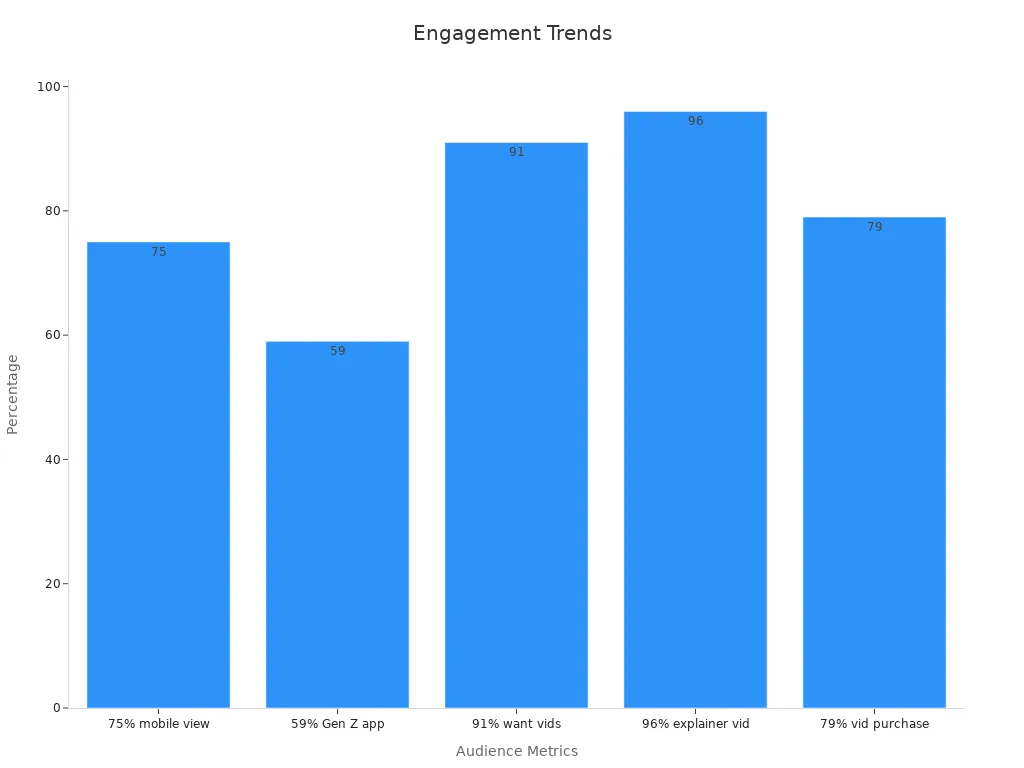
Audio visual communication, or "What Is Audio Visual Communication?", combines sound and visuals to share ideas or information. It helps you understand messages more clearly by engaging both your hearing and sight. This method makes communication more effective and memorable. For example, live polling during events creates a dynamic experience. Tools like digital polling platforms allow you to participate, whether you attend in person or remotely. In fact, 81.8% of virtual event planners use live polling to boost engagement. Displaying results from these polls encourages discussion and helps you connect with the material. This shows how audio visual strategies enhance communication in today’s world.
Audio visual communication uses sound and pictures to explain ideas better.
Combining sound and visuals helps people remember more, up to 65%.
Technology is important for making audio visual communication work well in groups.
This method is flexible and used in schools, jobs, and hospitals to help people understand and work together.
Try using easy tools like videos or slides to share ideas and connect with others.
Audio visual communication refers to the use of both sound and visual elements to share information or ideas. It combines what you hear and see to make messages clearer and more engaging. Modern literature defines audio-visual media as content that uses these two components to capture attention effectively. This approach is widely used in areas like education, advertising, and entertainment because it helps people understand and remember information better.
Audio visual communication has several key features that make it effective. First, it integrates visuals, such as images or videos, with sound to create a complete experience. Experts agree that visuals enhance communication by saving time and improving understanding. Second, it relies on technology, like projectors, screens, and speakers, to deliver messages. Finally, it adapts to different audiences and purposes, whether you’re learning in a classroom, watching a movie, or attending a business presentation.
A study from Carnegie Mellon University highlights the importance of audio cues in communication. It found that video conferencing can sometimes reduce group collaboration because not everyone contributes equally. This shows how balancing audio and visual elements is crucial for effective communication.
You encounter audio visual communication in many parts of your day. For instance, when you watch a YouTube tutorial, the combination of spoken instructions and on-screen visuals helps you learn faster. In schools, teachers use videos and presentations to explain complex topics. Businesses use it in meetings, where slides and audio discussions work together to share ideas. Even entertainment, like movies or video games, relies on this method to keep you engaged.
By blending sound and visuals, audio visual communication makes everyday interactions more meaningful and impactful.

Sound plays a vital role in audio visual communication. It conveys emotions, sets the tone, and ensures clarity in delivering messages. For example, in presentations or meetings, clear audio enhances understanding and keeps the audience focused. Studies reveal that poor sound quality increases listening effort, which can reduce comprehension and retention.
The transition from 'hi-fi' sound environments, where auditory information was clear, to 'lo-fi' soundscapes filled with background noise highlights the importance of sound clarity. Modern audio technologies aim to recreate the immersive and participatory nature of earlier soundscapes.
Audio enhancement technologies, such as noise-canceling microphones and advanced speakers, improve sound quality. These tools ensure that your message reaches the audience without distractions, making communication more effective.
Visuals are equally important in audio visual communication. They capture attention, simplify complex ideas, and enhance memory retention. Research shows that visuals improve learning by up to 400% and are processed 60,000 times faster than text.
Capture Learners' Attention: Visuals attract and maintain interest, increasing engagement.
Simplify Complex Information: Charts, diagrams, and videos break down intricate concepts into manageable parts.
Enhance Memory Retention: Images and videos create mental associations, aiding recall.
Promote Critical Thinking and Creativity: Analyzing visuals encourages deeper understanding and innovation.
90% of information transmitted to the brain is visual. This makes visuals a powerful tool for creating memorable and impactful communication.
Technology forms the backbone of audio visual communication. It integrates sound and visuals seamlessly, enabling effective message delivery. Key tools include audio and video conferencing systems, digital displays, and interactive technologies. These tools foster collaboration, engagement, and retention.
Component | Description |
|---|---|
Audio and Video Conferencing | Real-time communication across multiple endpoints, enhancing collaboration. |
Digital Displays and Signage | Continuous-use displays that improve information delivery and audience engagement. |
Interactive Technologies | Tools that engage users directly, fostering better retention through participation. |
Audio Enhancement Technology | Devices that improve sound quality, ensuring clarity during presentations and meetings. |
Control Systems | Systems that streamline the operation of various AV components, enhancing user experience. |
The adoption of these tools continues to grow. In 2023, the audio visual communication market reached USD 4.7 billion, with a projected value of USD 10.3 billion by 2033. North America leads with a 40.3% revenue share, reflecting the increasing reliance on advanced AV solutions.

Audio and visuals work together to create a seamless communication experience. When combined, they engage multiple senses, making it easier for you to understand and remember information. For example, in entertainment venues like concert halls, high-quality audio-visual systems create immersive experiences that captivate audiences. Similarly, in classrooms, interactive multimedia content, such as videos paired with narration, makes learning more engaging and effective.
Incorporating both elements fosters better communication outcomes across various fields:
In corporate settings, integrated AV systems encourage collaboration and meaningful interactions, leading to a more engaged workforce.
In education, they enhance student-teacher communication and improve learning outcomes.
In healthcare, AV integration supports real-time communication among providers, improving patient care and reducing errors.
By blending sound and visuals, you can deliver messages that are not only clear but also impactful.
Modern technology plays a crucial role in delivering integrated audio-visual content. It ensures that sound and visuals align perfectly, creating a cohesive experience. For instance, digital tools like video conferencing platforms allow you to share presentations with synchronized audio and visuals, making remote meetings more effective.
Key advancements in AV technology include:
The shift from analog to digital systems, which improves content quality and simplifies storage and distribution.
Tools that enable live-streamed lectures and virtual classes, bridging distances and providing global access to education.
Devices like digital whiteboards and specialized audio equipment, which support diverse teaching methods and accessibility needs.
These technologies make it easier for you to communicate effectively, whether you're in a classroom, office, or entertainment venue.
Audio visual communication enhances how you share and receive information by making it more engaging and memorable. Studies show that attention improves when audio and visuals are congruent, as your brain processes the information more efficiently. For example, in training rooms, instructors use AV systems to present lectures with videos, charts, and clear audio, ensuring participants stay focused and retain more information.
Metrics like viewer engagement, completion rates, and click-through rates highlight the effectiveness of AV communication. High-quality visuals paired with clear audio not only capture attention but also encourage action, whether it's completing a course or making a purchase. By leveraging AV tools, you can create communication experiences that resonate with your audience and achieve your goals.
Audio visual communication significantly improves how well you understand and remember information. By combining sound and visuals, it engages multiple senses, making learning more effective. Studies show that when you rely on audio alone, you retain only 10% of the information after 72 hours. Visuals alone increase retention to 35%. However, when audio and visuals are combined, retention jumps to 65% after the same period.
After just 32 seconds:
Visual retention is about 80%.
Auditory retention is about 60%.
This combination helps you process information faster and store it in your memory for longer. For example, watching a video tutorial with clear narration and visuals makes it easier to grasp complex ideas compared to reading a text-only guide.
Audio visual content keeps you more engaged than traditional communication methods. Videos, animations, and interactive elements capture your attention and hold it longer. For instance, 75% of adults in the U.S. watch short-form videos on mobile devices, and 91% of consumers want to see more online videos from brands. These statistics highlight how AV content resonates with audiences across different platforms.
Here’s a breakdown of how AV methods enhance engagement:
Statistic | Source |
|---|---|
96% of consumers have watched an explainer video to learn about a product. | HubSpot |
79% of people were convinced to purchase software due to a video. | HubSpot |
Short-form video has the highest ROI of all marketing trends. | HubSpot |

By using AV communication, you can create content that not only informs but also entertains, ensuring your audience stays connected.
Audio visual communication adapts to various industries, making it a versatile tool. In education, teachers use videos and interactive presentations to simplify complex topics. Businesses rely on AV tools for marketing campaigns, product demonstrations, and virtual meetings. In healthcare, AV systems support telemedicine and training for medical professionals. Entertainment industries, such as film and gaming, use AV technology to create immersive experiences.
This versatility allows you to tailor AV communication to meet specific needs. Whether you’re explaining a product, teaching a class, or entertaining an audience, AV tools help you deliver your message effectively.

Audio visual communication has transformed how you learn and train. By combining sound and visuals, it makes complex topics easier to understand and remember. For example, teachers use videos, animations, and interactive presentations to explain lessons in classrooms. This approach engages students and improves learning outcomes.
Evidence Type | Description |
|---|---|
Dual Channel Learning | Using both visual and verbal channels enhances retention and transfer of information. |
Student Engagement | Shorter videos (less than 6 minutes) maintain close to 100% engagement. |
Conversational Style | A conversational tone in video narration increases learning effectiveness. |
Training programs also benefit from audio visual tools. Companies use simulations and video tutorials to teach employees new skills. These methods save time and ensure better retention compared to traditional lectures. Whether in schools or workplaces, audio visual communication helps you learn faster and more effectively.
In business, audio visual communication plays a key role in engaging customers and promoting products. Videos, digital signage, and interactive ads grab attention and convey messages clearly. For instance, businesses use explainer videos to showcase products, making it easier for you to understand their features.
The global Audio-Visual Over Internet Protocol market was valued at $4.32 billion in 2022.
It is projected to reach $8.64 billion by 2032, growing at a CAGR of 8%.
Digital signage offers real-time updates and diverse content, making it a preferred method for client engagement.
These tools also enhance internal communication. Video conferencing and presentations help teams collaborate effectively, even across different locations. By adopting audio visual strategies, businesses can connect with their audience and achieve better results.
The entertainment and media industries rely heavily on audio visual communication to create immersive experiences. Streaming platforms, movies, and video games combine sound and visuals to captivate you. For example, advancements in AV hardware have made it possible to enjoy high-quality content on smart devices.
The rise of streaming services has reshaped consumer preferences. You now expect multifunctional devices that deliver seamless audio and video experiences. Businesses in this sector are investing in AV technology to meet these demands. This trend highlights the growing importance of audio visual components in entertainment, making your viewing experiences more engaging and enjoyable.
Audio visual communication has revolutionized healthcare by improving how you access information and interact with medical professionals. It enables hands-free communication between healthcare staff and patients, especially when physical presence is not possible. For instance, telemedicine platforms use video conferencing and digital tools to connect you with doctors, allowing consultations from the comfort of your home. This approach ensures timely care and reduces travel-related stress.
Patient education has also benefited from audio visual tools. Health organizations use videos and animations to explain medical conditions and treatments in a way that’s easy for you to understand. A notable example is the AMD case study, where a health organization created an animated video series to educate patients. The first chapter alone garnered 39,000 views and received positive feedback, demonstrating how engaging visuals can simplify complex medical information.
Hospitals and clinics use AV systems to enhance training for healthcare professionals. Interactive simulations and video tutorials help doctors and nurses learn new procedures effectively. These tools improve skill retention and ensure better patient care. For example, surgical training programs often use 3D animations to demonstrate techniques, giving you confidence in the expertise of medical teams.
Beyond healthcare, audio visual communication supports industries like public safety and environmental science. Emergency response teams use AV tools to coordinate rescue operations and share real-time updates. Conservationists rely on videos and presentations to raise awareness about environmental issues. These applications show how AV technology helps solve problems and create meaningful connections across diverse fields.
By integrating sound and visuals, audio visual communication makes healthcare and other industries more efficient, accessible, and impactful.
Audio visual communication combines sound and visuals to deliver clear and engaging messages. Its components, such as sound, visuals, and technology, work together to create impactful experiences. You benefit from better understanding, increased engagement, and versatile applications across industries like education, business, and healthcare.